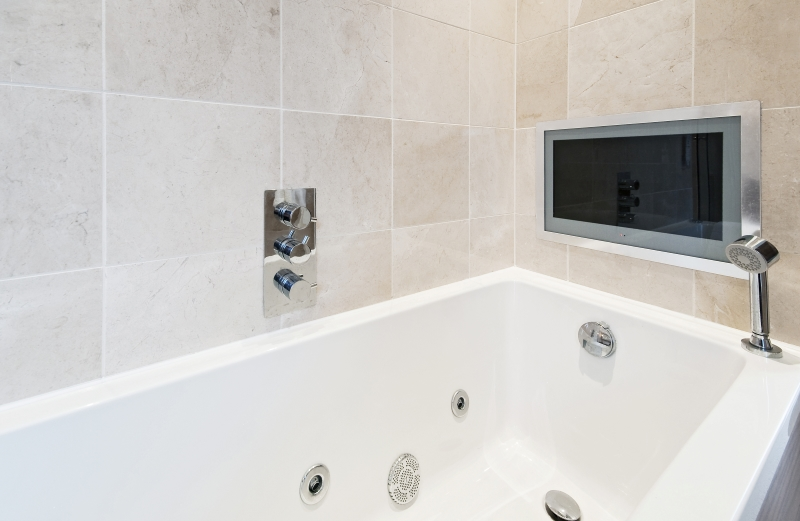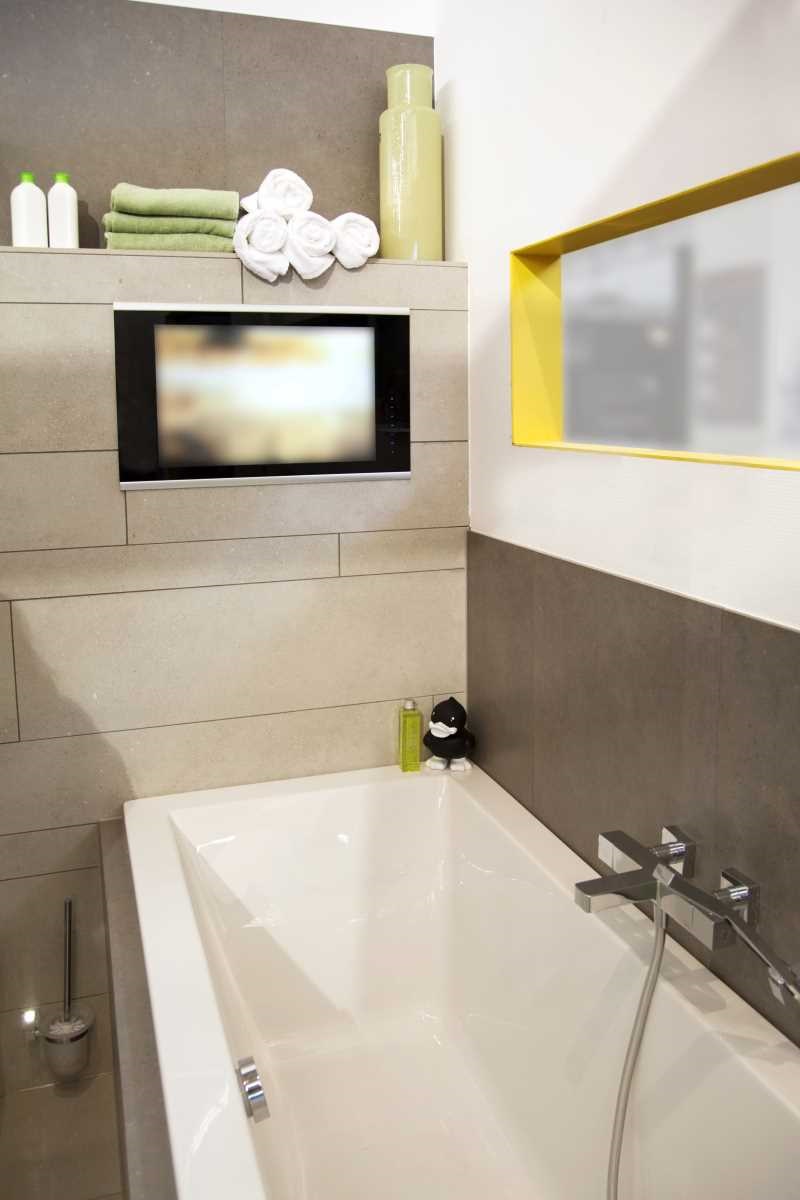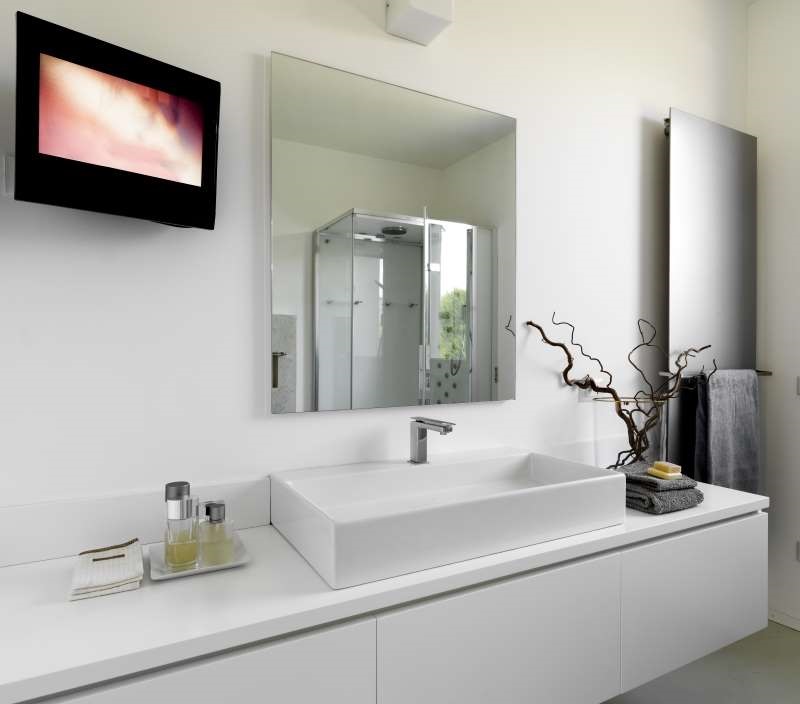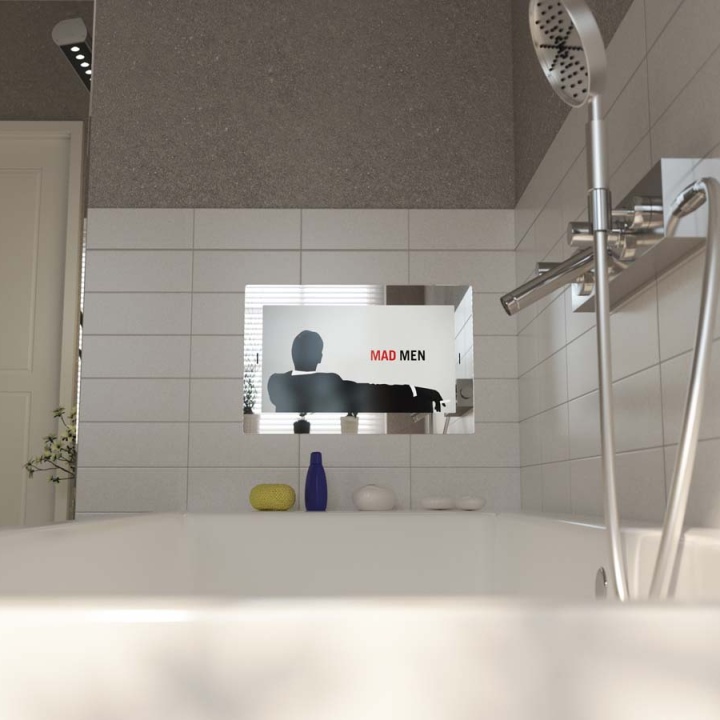With streaming platforms, digital television and video-on-demand, the modern household has never been blessed with as many options now in terms of content. Whether it is reality television, the latest documentary, or a good boxset, it’s easy to get hooked into a series that you don’t want to pause. If you enjoy a good soak in the bath but don’t want to miss a minute, then installing a bathroom TV could be the solution for you. We will cover what to look for, safety tips and how to install a TV in your bathroom in this guide.
Let us set the scene: you’re relaxing in a hot bath with candles, bubbles, maybe even a drink. No longer do you have to take those annoying TV breaks, be at risk of spoilers by being behind everyone else or avoid TV because you don’t have the time. A TV in your bathroom sounds like a good solution, right?
As a trend, the demand for bathrooms with televisions has been steadily growing over the years. In fact, Google figures show that there were on average 210 people searching monthly in the UK for ‘bathroom tv ideas’ in 2020 compared to just 40 in 2018, a rise of 425%.
It seems like something more suited to a lavish, upmarket hotel but as viewing habits change, there’s a lot more demand for a more family-friendly and tech-suited space.
Can You Have a Television in a Bathroom?

Firstly, to address the question of whether you can actually have a television in your bathroom.
The simple answer to this question is that, yes, you can have a television in your bathroom in the same way as you can have an electrical towel radiator, bathroom lights, and an LED mirror. However, like anything electrical, it needs to be considered carefully alongside the size of the room, where you want it, the ventilation of the room and with stringent safety regulations in mind. Additionally, the television must be waterproof and there are brands that specialise in these, which not many people are aware of.
Do You Actually Need a TV in Your Bathroom?
With tablet and mobile usage growing and streaming available at the tap of a finger, it seems like the need for a bathroom tv may have already been bypassed. However, statistics don’t marry up with this assumption. Despite over 54% of homes in the UK having access to at least one tablet based on 2015 Ofcom research, according to the Broadcasters Audience Research Board (BARB), which measures and tracks audience and TV ratings, in the third quarter of 2020 viewing figures for the most watched programmes on tablet or mobile only reach figures of around 75-90,000 people (data taken from BARB - page no longer available). Netflix has also reported that 70% of its viewing ends up on connected TV than mobile devices.
So, if you’re content with a small screen, or simply prefer a moment to contemplate, reflect and bathe in quiet, then you may not feel like a bathroom TV is warranted. However, if you do like to relax with a device, unless you purchase a bath rack capable of balancing a tablet up, you will have to contend with the fact that holding it or using it around the bathtub could risk water damage. This is likely to mean irreversible damage – an expensive mistake to make.
A television, therefore, could be a better solution all around. You can get a Smart TV with Freeview, which not only connects to all your main channels but also features apps like Netflix, Amazon Prime, YouTube and Twitch, as well as On Demand like ITV Hub and BBC iPlayer.
What is a Bathroom Safe TV and What Regulations Do They Have to Adhere to?
A bathroom safe TV is one that can withstand moisture. Regular TVs are not suited for being in damp or humid conditions, which can quickly cause irreparable damage to them. For that reason, if you are buying a TV, you will need to purchase one that has been built specifically to be waterproof and has been thoroughly tested to regulatory standards.
Not many people are aware that waterproof televisions exist, however, there are a few well-known brands on the market including Watervue, Proofvision and Sarason. To be suitable for a bathroom environment, they must be rigorously tested against certain safety standards.
IP Rating
The first thing to note is the IP rating of the television set. This stands for ‘Ingress Protection’ and is a measurement of defining how much intrusion a device or component can withstand from foreign substances, such as dirt, dust, water, and users.
Each digit determines how protective it is against a substance, with the first being for dust and dirt (on a scale of 0-6) and the second for moisture (on a scale of 0-8). The higher the numbers, the better it is.
In terms of moisture, which is the main concern for televisions, an ideal rating should be anything above 5, which is low pressure jets from any angle. However, the higher the better – 8, as an example, means it can be submerged. In terms of TV ratings, you will see anything suitable for bathrooms rated as IP65 (the minimum standard) to IP68.
CE
The CE mark is one that is recognisable and quite common on many products and items available to buy. This is a European standard that demonstrates that the manufacturer has checked and tested a product to meet with EU safety, health, and environment requirements.
Restriction of Hazardous Substances (RoHS)
Restriction of Hazardous Substances (RoHS) compliance means that the product has been tested for 10 banned substances – including the likes of Cadmium and Lead – by an independent organisation, and that it is below the designated threshold. All electricals and electrical components must adhere to this.
Waste Electrical or Electronic Equipment (WEEE) Directive
WEEE stands for Waste Electrical or Electronic Equipment and is another European directive. The aim of WEEE is to increase electrical recycling from households and usually features a symbol of a wheelie-bin crossed out to show that an item should not be put in household waste. WEEE puts responsibilities on the manufacturer and retailer to design products with recycling in mind, so that consumers can disassemble and return them for recycling free of charge, usually through household recycling centres in the UK.
What Types and Sizes of Bathroom TV Can You Get?
There are generally around three types of bathroom, or waterproof TVs, available. The first is a standard television with built-in Freeview, which will allow you to watch all the major channels. If you’re looking for an upgrade, then you can also get a smart TV, which connects to the Internet using wi-fi, allowing you to use streaming apps and channels like Netflix.
The final feature to consider is whether you want a television screen that also doubles up as a mirror. These televisions have a shiny, mirrored surface, which means you can use it for everyday bathroom activities when the screen is turned off.
The sizes of bathroom TVs that can be bought range from small and compact, such as 19 inches, all the way up to 55”.
Are There Any Problems With Having a TV in The Bathroom?
The major problem with having a traditional television in the bathroom is that they don’t necessarily meet the specifications for such an environment. As such, they present a health and safety risk, and can be easily damaged by humidity and moisture. As such, you should never try adding a standard television into your bathroom. If you have a waterproof model, then as long as they comply with the regulations, they are built to be protected against such issues.

Location and Bathroom Zones
Models and products aside, the other major issue to consider is where you intend to put the television. Location is vitally important, and the starting point is to understand about bathroom zones and what these are.
For the purposes of electrics and lighting, bathrooms are split up into four zones:
- Zone 0 – This is anything inside wet areas themselves, such as inside the bath or shower. Anything used in this zone needs to be compliant with the highest IP ratings, such as IP67 or IP68, so they can withstand submersion.
- Zone 1 – This is anything above the bath or shower, such as the walls and fittings, up to a height of 2.25m from the floor. Anything in this zone should adhere to IP65 or higher, however, consult the manufacturer of the television to see if they recommend a specific zone only for their television when installing.
- Zone 2 – This is surrounding areas of basins, taps, baths and outside walls of showers. This covers anything of 60cm/0.6m from the edges of baths and showers, and to a height of 2.25m like Zone 1. As a minimum, IP44 is recommended for these areas.
- Zone 3/Outside areas – This zone covers anything outside of the above areas, where water is not likely to be used or in close proximity.
In terms of bathrooms, since the proximity to moisture is significant, it’s worth considering this when deciding where to place it.. Since it is unlikely that you will want to put your TV in a zone 0 area, then a TV that is IP65 or higher would be suitable for any area of your bathroom.
Beyond this, it’s also worth bearing in mind your line of sight. While there is no one place you should put a television, a lot of people choose to place it on a bath-facing wall. An alternative, is installing it above your basin for mirrored types. However, when doing this it’s worth considering any existing fixtures and fittings, such as taps, showers and riser rails, or existing wall features.
How Do You Install a Bathroom TV?
If you’ve got this far and you’re ready to buy a bathroom television, or you already have one and want to know how to install it then this is how you would go about doing it.
NOTE: It’s worth mentioning that you should undertake any work through a suitably qualified electrician to ensure the work is done to an appropriate standard and adheres to up-to-date safety and electrical regulations.
1. Make Sure You Have All the Parts Present And That You Have Tested the Television Works
2. Choose A Location
The first step in installing a bathroom television is to decide where you want it to be located. Bathroom televisions can be installed in two ways:
- VESA / Wall Mounted – VESA is a wall-mounting method and is a standard used to fix a TV to a wall using the four holes at the back of the TV. If you are using this method, in the interests of safety, you should consult the make of your waterproof TV to see if they recommend placing this in a Zone 2 location, as they may not be suitable for zone 1.
- Recessed into the wall itself – Most manufacturers recommend as a preferred method of installation. This means creating a wall ingress that installs the TV flat and flush within a wall. For the purposes of this guide, we’re advising of the steps to follow this method.
The wall itself you are looking to install into should be flat and level, and not angled in any way.

3. Do the Electricals
You should ensure the electrical aspects are done first through an electrician, and that the cables and transformers are run (or chased) to the area you want the TV.
4. Create the Recess and Fit Back-mounting Plate
You should next create the recess for the back-mounting plate to fit to. This step may also require you to have tradespeople like plasterers and tilers on standby just in case you need to tidy up areas. Measure out the recess using the back-mounting plate and using a spirit level if required to make sure it is flat. Always double-check the recess is sized the same as that of the dimensions specified.
Once you have cut the recess, you should install the back-mounting plate into the recess. Push back into the recess until it doesn’t move further, and secure in place with screws or in line with the manufacturer installation guide. The plate should line up with the tile or wall edge for a neat finish.
5. Connect Cables to the Television
You should then connect the cables to the television. Bring through the cables underneath the installed plate first, and then fix into the inputs at the back of the TV, such as power, HDMI, and any other features you want adding such as Chromecasts.
6. Push the TV into the Wall and Test it Fits and Works
You may need a glass suction lifter at this stage to help with fixing and also to ensure you don’t drop the TV. Some TVs include magnets to help fix the TV in place so check your model first and if they do, do not remove any magnet covers until you have completed this step. You should do a test run, if you can, to make sure the TV fits appropriately into the back-mounting plate before proceeding further, and that the TV turns on.
7. Remove Any Magnet Covers and Seal Around the Edge
Once you are satisfied that the television fits, remove it from the recess again, take out the cables and lie on a flat surface. Remove any magnet covers and then add silicone-based sealant around the edges of the back of the television. You should always ensure you follow the guidance of adding sealant, if advised in the manufacturer’s installation guide, to avoid the risk of voiding any warranty you may have in the event of faults or damage.
8. Fix Back Into the Wall
After applying the sealant, fix back into the mounting plate and push until secure and the magnets (if any) securely hold the TV. Leave for a period, such as 24 hours, before using just to ensure the sealant is dry.
VESA Installation
If you are not following the recess method, but attaching via VESA mount, then you should ensure that it is secure against the wall and that you follow any advice appropriately.
Bathroom televisions are a great way to ensure you don’t miss out on watching all your favourite programmes. If you have any queries, or would like to know more about bathroom televisions, then reach out and we’ll be more than happy to help.

